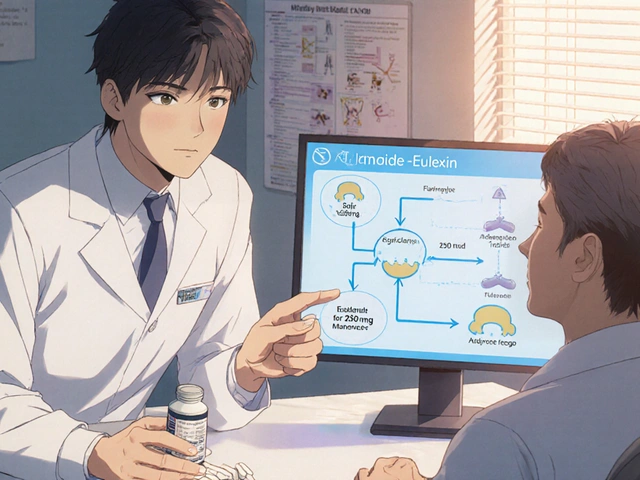For years, people have linked chronic pain to low mood. But what if the drug you take for joint pain could also be quietly affecting your emotions? Celecoxib, a common NSAID used for arthritis and inflammation, has shown up in surprising places - including studies on depression. It’s not an antidepressant. It doesn’t target serotonin or dopamine. Yet, something about how it works in the body might help lift the fog of depression - or make it worse. Here’s what the science actually says.
What is celecoxib, really?
Celecoxib is a COX-2 inhibitor. That means it blocks a specific enzyme - cyclooxygenase-2 - that triggers inflammation and pain. Unlike older NSAIDs like ibuprofen or naproxen, it doesn’t mess much with COX-1, the enzyme that protects your stomach lining. That’s why doctors prescribe it for people with a history of ulcers or GI issues. It’s sold under brand names like Celebrex and is available as a generic. People take it daily for osteoarthritis, rheumatoid arthritis, or acute pain after surgery.
But inflammation isn’t just about swollen knees. It’s a system-wide signal. When your body is fighting off infection, injury, or even stress, it releases chemicals called cytokines. These can cross the blood-brain barrier. And when they do, they can mess with brain chemistry in ways that mimic depression.
The inflammation-depression link
Research over the last 15 years has shown that people with depression often have higher levels of inflammatory markers in their blood - like CRP, IL-6, and TNF-alpha. This isn’t just a side effect. It might be part of the cause. In fact, some patients with treatment-resistant depression respond better to anti-inflammatory drugs than to standard antidepressants.
One 2019 meta-analysis published in JAMA Psychiatry looked at 14 clinical trials involving over 2,000 people. It found that adding an anti-inflammatory medication - including celecoxib - to standard antidepressant treatment led to significantly greater symptom reduction than antidepressants alone. The effect was strongest in people with high baseline inflammation.
Another study from 2022 tracked 86 patients with major depressive disorder. Half got fluoxetine (Prozac) plus celecoxib. The other half got fluoxetine plus placebo. After six weeks, the celecoxib group showed a 47% greater drop in depression scores. Their fatigue, sleep issues, and brain fog improved faster too.
How could a painkiller affect your mood?
It’s not magic. It’s biology.
Celecoxib reduces inflammation in the brain by lowering cytokine levels. These cytokines interfere with the production of serotonin and dopamine - the brain’s natural mood stabilizers. They also activate microglia, the brain’s immune cells. When overactive, microglia can damage neurons and reduce neuroplasticity - your brain’s ability to adapt and heal.
Think of it like this: chronic pain keeps your body in a state of high alert. Your immune system stays switched on. That constant noise spills into your brain. Over time, your mood circuits get worn down. Celecoxib doesn’t fix your thoughts. But it quiets the background hum of inflammation that’s making those thoughts harder to shake.

Who might benefit?
Not everyone with depression will respond to celecoxib. But if you fit this profile, it’s worth discussing with your doctor:
- You’ve tried at least two antidepressants with little or no improvement
- You have a chronic inflammatory condition - like arthritis, Crohn’s, or psoriasis
- Your blood tests show elevated CRP or other inflammatory markers
- You feel physically heavy - sluggish, achy, unable to get out of bed - even when your mood feels “better”
There’s also emerging evidence that people with obesity-related depression respond better to anti-inflammatories. Fat tissue produces cytokines. More fat = more inflammation = higher depression risk. Celecoxib may help break that cycle.
What about risks?
Celecoxib isn’t harmless. It’s still an NSAID. Long-term use raises your risk of heart attack, stroke, and high blood pressure - especially if you’re over 65, smoke, or have existing heart disease. The FDA issued a black box warning in 2005, and it still stands.
It’s also not safe if you have kidney problems, are pregnant, or are allergic to sulfa drugs. Celecoxib contains a sulfa component. If you’ve had a reaction to sulfa antibiotics like Bactrim, skip it.
And here’s the big one: celecoxib should never replace antidepressants. It’s not a standalone treatment. It’s an add-on. Taking it without medical supervision can be dangerous. Stopping antidepressants cold turkey can trigger withdrawal or worsen depression.

What do real patients say?
Online forums are full of mixed stories. One woman in her 50s with rheumatoid arthritis wrote: “I was on sertraline for two years. Still felt like I was underwater. Started celecoxib for my knees. Within three weeks, I started crying at commercials - but it was the first time I cried because I felt something, not because I was numb.”
Another man, 68, with knee pain and mild depression, said: “I thought the pain was making me sad. Turns out the inflammation was making both worse. After six months on celecoxib, I’m sleeping through the night and walking without a cane. My therapist asked if I started therapy. I said no - I just stopped being sick.”
But not everyone has good results. Some report increased anxiety, dizziness, or nausea. Others notice no change at all. That’s why testing inflammation levels matters. If your body isn’t inflamed, celecoxib won’t touch your mood.
What’s the bottom line?
Celecoxib isn’t a miracle cure for depression. But for a specific group - people with high inflammation and treatment-resistant depression - it’s emerging as a powerful tool. It doesn’t fix trauma, loneliness, or life stress. But it removes a biological barrier that’s keeping antidepressants from working.
If you’ve been stuck on medication after medication with no relief, ask your doctor for a simple blood test: CRP or ESR. If your levels are high, talk about whether adding celecoxib might help. Don’t self-prescribe. Don’t stop your current meds. But don’t ignore the possibility that your depression might be partly physical - not just psychological.
Depression isn’t always in your head. Sometimes, it’s in your joints. And sometimes, the key to feeling better isn’t more talk therapy - it’s quieting the inflammation that’s been screaming inside you for years.
Frequently Asked Questions
Can celecoxib cause depression?
There’s no strong evidence that celecoxib causes depression. In fact, most studies show the opposite - it may reduce depressive symptoms in people with high inflammation. However, like all medications, it can have side effects. Some users report mood changes, including anxiety or irritability, especially when starting or stopping the drug. If you notice new or worsening mood symptoms, talk to your doctor.
How long does it take for celecoxib to help with depression?
In clinical trials, mood improvements started showing up around 2 to 4 weeks after starting celecoxib, with the strongest effects seen by week 6. This matches the timeline for traditional antidepressants. It’s not an instant fix. You need to take it consistently, and it works best when combined with an antidepressant - not alone.
Is celecoxib better than other NSAIDs for depression?
Celecoxib has been studied more specifically for depression than other NSAIDs because it’s selective for COX-2, which is more involved in brain inflammation. While ibuprofen and naproxen also reduce inflammation, they affect COX-1 more, which can lead to more side effects. No direct head-to-head trials exist yet, but celecoxib’s cleaner profile makes it the preferred choice in research settings.
Do I need a blood test before trying celecoxib for depression?
It’s not mandatory, but it’s highly recommended. Testing for C-reactive protein (CRP) or erythrocyte sedimentation rate (ESR) tells you if inflammation is driving your symptoms. If your levels are normal, celecoxib is unlikely to help your mood. If they’re high, you might be a good candidate. Many doctors don’t test for this - so you may need to ask.
Can I take celecoxib with SSRIs like Zoloft or Prozac?
Yes - and that’s exactly how it’s been studied. Multiple trials combined celecoxib with SSRIs and found better results than SSRIs alone. No dangerous interactions have been reported. But always tell your doctor about everything you’re taking. Even safe combinations need monitoring, especially if you have heart or kidney issues.




